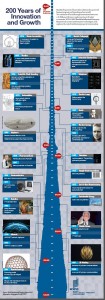I’ve been dipping into the truly fascinating World Intellectual Property Report from WIPO, published last week. The overview chapter has a beautifully clear overview of economic growth, and the role of innovation and IP rights. The rest of the report falls into two sections: case studies of historical breakthrough innovations (airplanes, antibiotics, semiconductors); and case studies of newer innovations with breakthrough potential (3D printing, nanotechnology and robotics).
The lessons drawn should not be surprising but seem hard for people looking at future growth prospects to absorb. For example, big innovations can affect growth through several routes (for example with antibiotics by the impact on human capital); their economic transformations are far-reaching, unpredictable and can take a long time; all breakthough innovations require continuous follow-on innovations, both technical and organizational; the specifics of the innovation ecosystem matter greatly, and have a geographical dimension; the structure of the ecosystem will change as the technology matures, steadily involving more professional and formal structures. Interestingly, the historical examples suggest that the IP system made far less difference to the wide dissemination of the technologies than the absorptive capacity of each country.
The report is free to download and – unusually for such official reports – a very good read. Its case study approach is illuminating and I learned a lot about the technologies I’m less familiar with.

200 years of innovation
